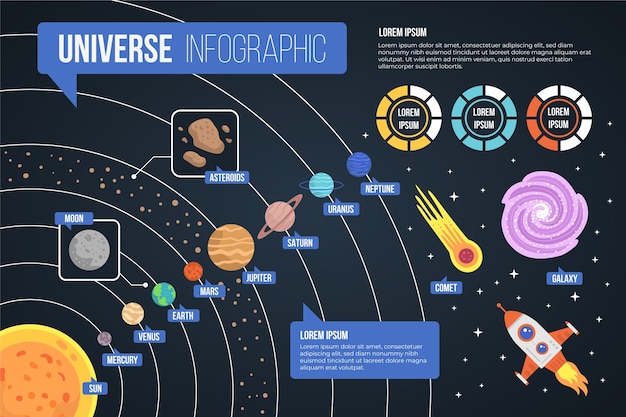Interesting Facts About Comets

Comets are icy celestial bodies that originate from the outer regions of our Solar System.
Comets are often referred to as dirty snowballs due to their composition of a mixture of ice, dust, and rock.
Halley’s Comet is one of the most famous comets, visible from Earth approximately once every 76 years.
Comets have distinct tails that form as they approach the Sun, due to the heat causing the ice to vaporize and create a glowing trail.
The tail of a comet can extend for millions of kilometers, making them a truly breathtaking sight in the night sky.
Comets travel in highly elliptical orbits around the Sun, taking them from the outer regions of the Solar System to relatively close proximity to our star.
The nucleus of a comet is the solid core made up of ice and rock particles, usually ranging from just a few kilometers to tens of kilometers in diameter.
Comets are often named after their discoverers or significant figures in the field of astronomy.
Comets have been observed by humans for thousands of years, with some ancient civilizations believing them to be celestial omens.
Comets played a significant role in the development of theories around the formation of the Solar System.
Comets contain valuable scientific data about the early stages of our Solar System’s formation.
The first successful mission to a comet was the European Space Agency’s Rosetta mission, which landed the Philae probe on comet 67P/Churyumov-Gerasimenko in 20
Interesting Facts About Comets part 2
Comets can sometimes collide with planets or other celestial bodies, causing significant impact craters.
Comets have highly elongated orbits, taking millions of years to complete a single revolution around the Sun.
The Oort Cloud is a hypothesized region of the Solar System where many comets are thought to originate.
Comets can have multiple tails, created by different gas emissions and dust particles being pushed away by solar radiation and solar wind.
Comets that approach the Sun more frequently and have shorter orbital periods are known as short-period comets.
Comets are often categorized based on their composition, with some being predominantly composed of water ice and others containing more volatile gases.
The composition of a comet’s tail can reveal valuable information about the composition of the nucleus and the processes occurring within the comet.
Comets can have irregular shapes, sometimes resembling a potato or even a rubber duck, as observed in the case of comet 67P/Churyumov-Gerasimenko.
Comets played a role in inspiring ancient myths and legends, with their appearance often interpreted as supernatural or celestial events.
Comets have been known to produce meteor showers as Earth passes through their debris trails.
The nucleus of a comet can experience outbursts, releasing bursts of gas and dust into space.
Comets are believed to have delivered water and organic compounds to Earth, potentially contributing to the development of life.
Comets can have highly elliptical orbits that take them beyond the boundaries of the Solar System.
Comets are considered time capsules due to their preservation of primitive materials from the early stages of the Solar System’s formation.
Comets can be observed using telescopes, both from Earth and through space missions.
Comets can have different colors, ranging from white to blue or even green, depending on the composition and gas emissions.
Comets have been depicted in various forms of art throughout history, symbolizing both beauty and mystery.
Comets have irregular rotation patterns, often spinning in a tumbling or spinning top-like motion.
Comets can have highly eccentric orbits, crossing paths with multiple planets within the Solar System.
The Great Comet of 1811 is considered one of the most spectacular comets ever observed from Earth.
Comets can experience fragmentation, where a single nucleus splits into multiple pieces.
Comets can be used as natural laboratories to study the effects of extreme heat, radiation, and low gravity on various materials.
Comets have been observed in different sizes, from small bodies barely a few meters in diameter to giant comets that can be hundreds of kilometers across.
Comets can have asymmetrical tails, indicating variations in the composition or activity of the nucleus.
Comets have been studied through the use of spacecraft missions, such as the Stardust mission that collected samples from the tail of comet Wild
Comets have been associated with both fear and fascination throughout history, often viewed as both harbingers of doom and objects of wonder.
Comets can have distinct shapes, often resembling a glowing halo or a cosmic jellyfish.
Comets can be unpredictable in their behavior, with some displaying unexpected outbursts and changes in brightness.
Comets can have highly elliptical orbits that take them extremely close to the Sun, subjecting them to intense heat and radiation.
Comets can have varying periods of activity, with some becoming dormant for long periods before displaying new outbursts of gas and dust.
Comets have been imaged by spacecraft missions from different angles, providing valuable insights into their structure and composition.
Comets are often studied using multiple instruments, including spectrographs and imaging devices, to analyze their composition and activity.
Comets continue to fascinate scientists and astronomers, with ongoing missions and research uncovering new discoveries about these enigmatic celestial objects.

